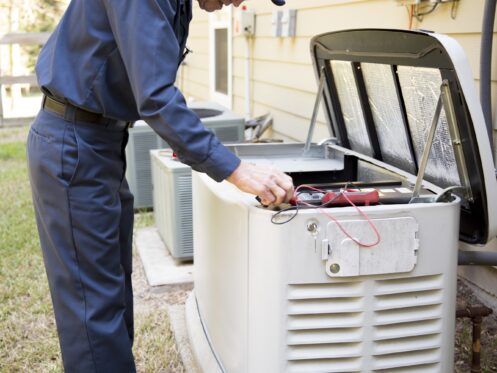Generators can be extremely useful in the event that the power goes out for any amount of time. Should there ever be a blackout or a major storm that causes the grid to go down, the generator will at least ensure you can still power the most important things. In today’s post, we’re going to look at exactly how whole home back-up generators produce electricity as well as how you can use a generator to power your home during a blackout.
How Generators Produce Electricity
Generators work by converting kinetic energy (motion) into electricity, and they do this through a process known as electromagnetic induction. Any time a magnet is moved through a conductive wire, the mechanical energy from the moving magnet produces an electrical current that flows through the wire.
Most generators have an internal combustion engine that burns fuel. Portable generators typically burn either gasoline or diesel fuel, whereas whole-home generators run on either natural gas or propane. The fuel is used to spin a rotating shaft that contains a strong electromagnet, and this electromagnetic shaft is known as an armature.
The armature spins inside of something known as a stator, which is essentially a series of copper wires or windings that produce a strong magnetic field. The electromagnetic armature and the stator are oppositely charged. When the armature spins inside of the oppositely charged magnetic field, the kinetic energy from the rotating shaft is converted into electrical energy that arcs between the stator and the armature.
Mounted onto the rotating shaft is something known as a commutator, which is a conductor that collects the electricity produced when the armature spins within the stator. As the shaft spins, the brush assembly continuously rubs against the commutator. This process allows the brush assembly to capture the electrical current so that the generator can then send the electricity out into whatever it is powering.
Whole-Home vs. Portable Generators
Both portable and whole-home generators produce electricity using this same electromagnetic induction process and function identically. The only real difference is that portable generators can only power appliances and devices that are plugged directly into the generator, whereas whole-house generators can also power hard-wired appliances. The reason is that a whole-house generator is directly wired into the home’s electrical system. It is also technically possible to connect a portable generator to your home’s electrical grid, but this is something we will look at in the next section.
Portable generators are typically smaller and less powerful, but there are some units that can produce a similar amount of wattage as a smaller whole-home generator. The issue is that portable generators are really only useful for emergency situations where you’re only without power for a few hours. A portable generator can be useful for plugging in lamps so you have lighting or charging your phone, but they typically won’t ever provide enough electricity to power your entire home. This isn’t an issue with whole-home generators as this type of unit can power your HVAC system and everything else in your home as long as you choose a unit that is properly sized and powerful enough to meet your home’s electricity needs.
The fuel tank on portable generators is also fairly small, which means you will need to add more fuel regularly to keep the generator running. This also isn’t an issue with whole-home generators since these units are either connected to a large propane tank or directly to your home’s natural gas supply. If the unit runs on propane, it should still be able to power your home for days without running out of fuel. If the generator is connected to the natural gas supply, it could theoretically run indefinitely. The reason we say theoretically is that you will still need to change the oil in the generator every 2,000 hours or so to keep the engine properly lubricated.
Understanding the Role of the Transfer Switch
Whole-home generators are permanently mounted outside of the building and have an electrical cable that runs to the home’s main electrical panel. However, this cable isn’t wired directly into the electrical panel and instead is connected to something known as a transfer switch. This is important as wiring any type of generator directly into the building’s electrical system is both extremely dangerous and illegal.
If the generator were to be wired directly into an electrical system, some of the electricity the generator produces would always flow back out of the home and into the municipal electricity grid. Having power flowing back out into the grid is extremely dangerous as it could electrocute anyone who is working on the grid and trying to restore the power.
A generator that is connected directly to the building’s electrical system could also easily overload the system. This is also extremely dangerous as an overload can lead to the electrical wiring becoming extremely hot and beginning to melt and potentially catching fire.
The transfer switch works to prevent all of these problems as it both isolates the home from the electrical grid whenever the generator is running and controls the flow of electricity to prevent the electrical system from being overloaded. Most whole-home generators use an automatic transfer switch, which continuously monitors the electricity flowing into the home. Whenever the switch detects that the power is out, it instantly signals the generator to start and isolates the home from the grid. Once the switch detects that power is flowing from the generator, it activates and closes the circuit so that the power from the generator then flows into the electrical panel and out into each of the home’s circuits.
While the generator is running, the transfer switch still continues to monitor whether electricity is flowing in through the grid. As soon as it detects that the power is back on, it signals the generator to turn off and then switches back so that the home is again powered by the grid.
There are also manual transfer switches that also function to isolate the home from the grid and allow power from the generator to flow into the home’s electrical system. The only difference is that manual transfer switches have to be switched on and off by hand instead of working automatically. This means that when the power goes out, you will need to go outside and turn the generator on and then go to your electrical panel and flip the transfer switch on. Once the power goes out, you will then need to again flip the transfer switch so that your home is again connected to the grid.
Manual transfer switches can still be useful as they will allow you to safely connect a portable generator to your home’s electrical system. Whenever the power goes out, you will need to start the generator and then run a special cord known as a gen cord into your house and plug it into the manual transfer switch. This can be extremely helpful for keeping things like your lights and refrigerator running during a blackout. However, you will usually need to shut off most of the circuit breakers so that you are only powering whichever circuits are absolutely necessary. If not, your generator will most likely get overloaded and shut down since your home is attempting to draw more power than the generator can supply.
Expert Generator and Electrical Services
At Aurora Pro Services Heating, Air, Plumbing, Electrical, & Roofing, we specialize in installing, servicing and repairing whole-home generators, and we can also assist if you need a transfer switch installed so you can safely connect your portable generator to your home. We can also inspect your electrical panel and your entire electrical system or help if you need whole-home surge protection or any other electrical repair or installation services in the Greensboro area. For more information on our generator services or to schedule an appointment, contact us today.






